Without Squanto's help as an interpreter, negotiator, and agricultural advisor, the Mayflower Pilgrims may not have survived their early years at Plymouth.
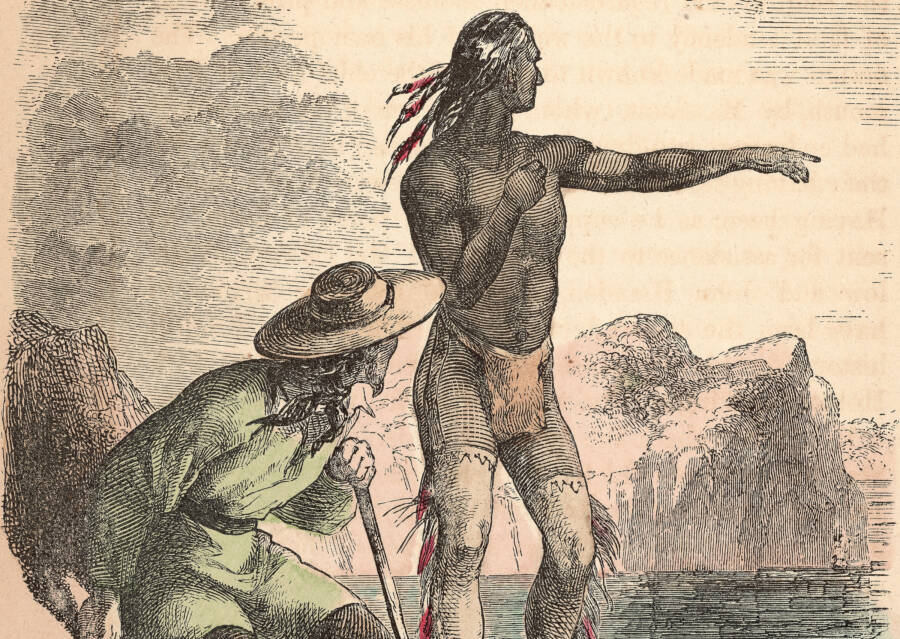
Getty ImagesAfter the Mayflower landed in Plymouth in 1620, the Patuxet tribesman Squanto served as an interpreter and guide who helped the Pilgrims survive.
According to the mythology behind the first Thanksgiving in 1621, the Pilgrims met a “friendly” Native American named Squanto in Plymouth, Massachusetts. Squanto taught the Pilgrims how to plant corn, and the settlers enjoyed a hearty feast with their new native friend.
But the true story about Squanto — also known as Tisquantum — is far more complex than the version that schoolchildren have been learning for decades.
Inside Squanto’s Early Life And Captivity In Europe
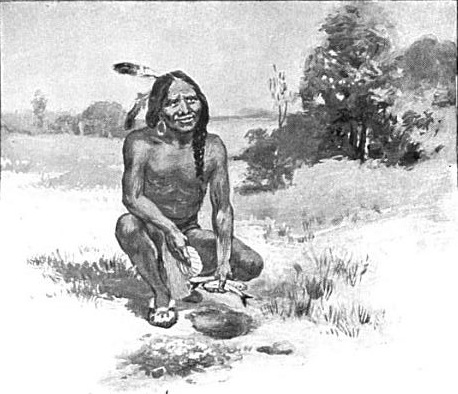
Wikimedia CommonsSchoolchildren are taught that Squanto was a friendly native who saved the Pilgrims, but the truth is more complicated.
Historians generally agree that Squanto belonged to the Patuxet tribe, which was a branch of the Wampanoag Confederacy. It was located near what would become Plymouth. He was born around 1580.
Although little is known of his early life, Squanto came from a village of hardworking and resourceful people. The men of his tribe would travel up and down the coast on fishing expeditions, while the women cultivated corn, beans, and squash.
Before the early 1600s, the Patuxet people generally had friendly contact with the European settlers — but that certainly didn’t last long.
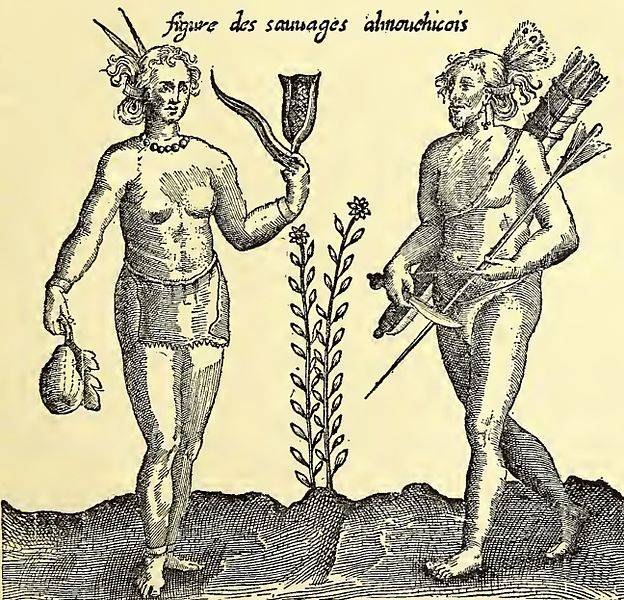
Wikimedia CommonsA French 1612 depiction of the New England “savages.”
At some point during his youth, Squanto was captured by English explorers and taken to Europe, where he was sold into slavery. The most widely-accepted theory is that Squanto and 23 other Native Americans boarded the ship of Captain Thomas Hunt, who put them at ease with promises of trade before setting sail.
Instead, the Natives were held captive aboard.
“This is not revisionist history,” said Wampanoag expert Paula Peters in an interview with Huffington Post. “This is history that’s just been overlooked because people have become very, very comfortable with the story of happy Pilgrims and friendly Indians. They’re very content with that — even to the point where no one really questioned how is it that Squanto knew how to speak perfect English when they came.”
The Patuxet people were outraged by the kidnappings, but there was nothing they could do. The Englishmen and their prisoners were long gone, and the remaining people of the village would soon be wiped out by disease.
Tisquantum Regains His Freedom And Returns To North America
Squanto and the other prisoners were likely sold by Hunt as slaves in Spain. However, Squanto somehow managed to escape to England. By some accounts, Catholic friars may have been the ones to help Squanto out of captivity. And once he was free in England, he began to master the language.
Mayflower Pilgrim William Bradford, who got to know Squanto very well years later, wrote: “he got away for England, and was entertained by a merchant in London, employed to Newfoundland and other parts.”
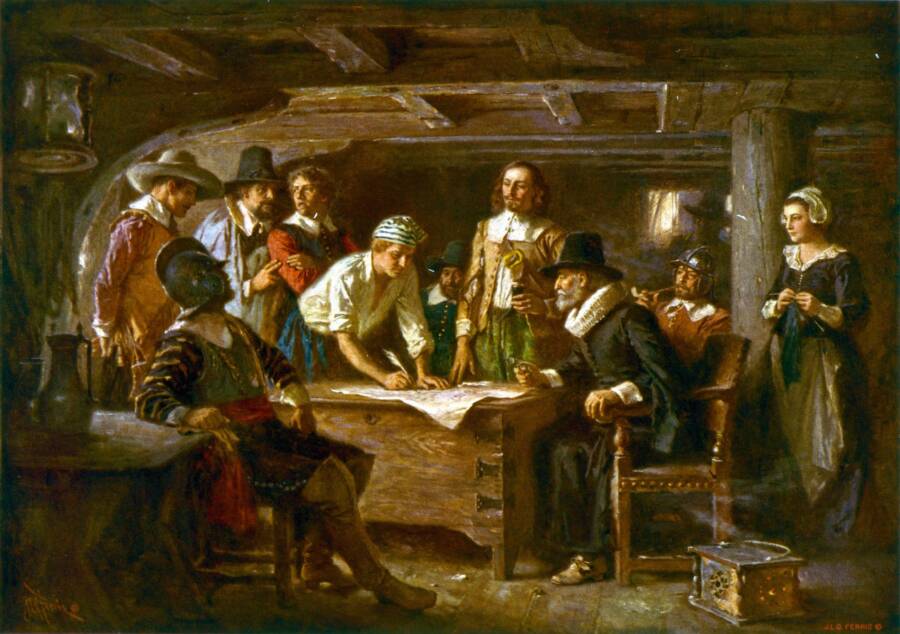
Wikimedia CommonsPilgrims signing the Mayflower Compact, including William Bradford (black hat, second from left).
It was in Newfoundland that Tisquantum met Captain Thomas Dermer, a man in the employ of Sir Ferdinando Gorges, an Englishman who helped found “the Province of Maine” back on Squanto’s home continent.
In 1619, Gorges sent Dermer on a trade mission to the New England colonies and employed Squanto as an interpreter.
As Squanto’s ship approached the coast, Dermer noted how they observed “some ancient [Indian] plantations, not long since populous now utterly void.” Squanto’s tribe had been annihilated by the diseases that the white settlers had brought with them.
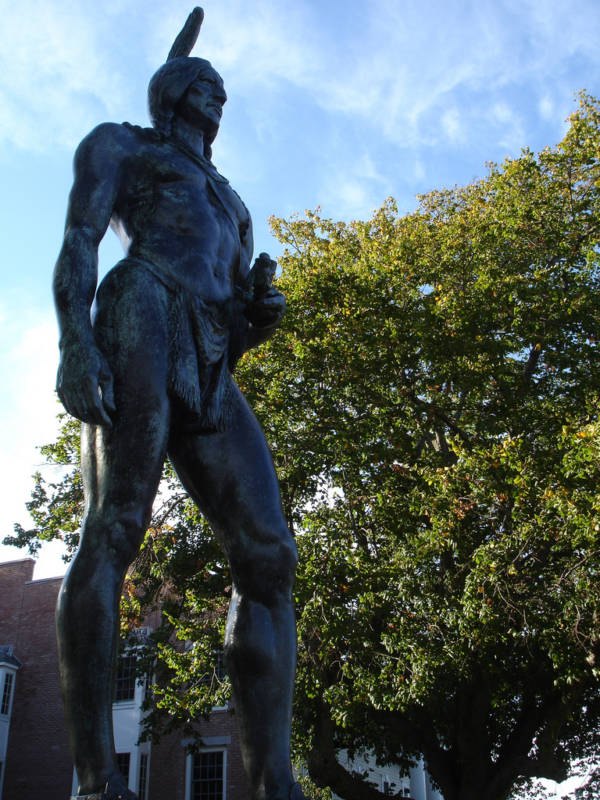
Flickr CommonsA statue of Massasoit, chief of the Wampanoag, in Plymouth.
Then, in 1620, Dermer and his crew were attacked by the Wampanoag tribe near modern Martha’s Vineyard. Dermer and 14 men managed to escape.
Meanwhile, Squanto was taken captive by the tribe — and he was longing for his freedom yet again.
How Squanto Met The Pilgrims
In early 1621, Squanto found himself still a prisoner of the Wampanoag, who cautiously observed a group of recent English arrivals.
These Europeans had suffered grievously in the winter, but the Wampanoag were still hesitant to approach them, especially since Natives who attempted to befriend the English in the past had been taken captive instead.
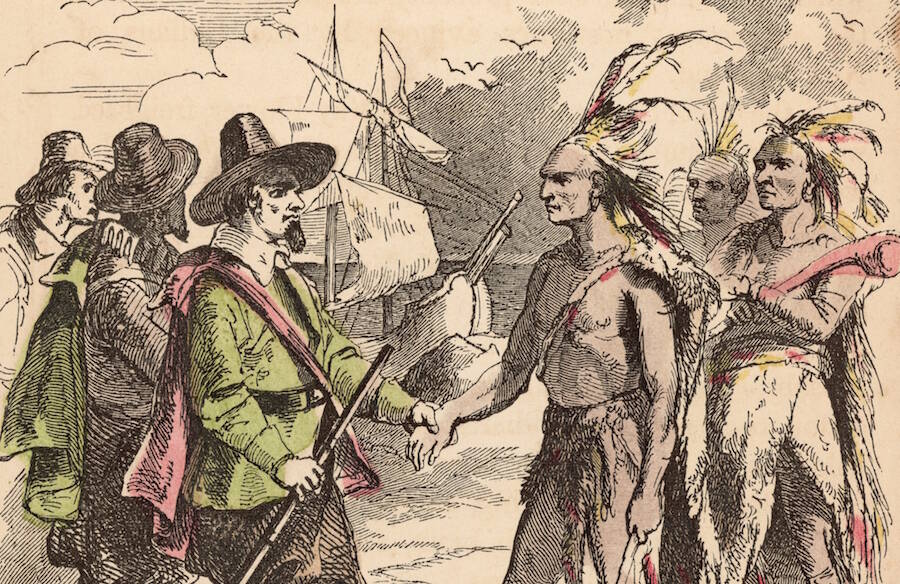
Getty ImagesSamoset, one of the first Native Americans to meet the Pilgrims, famously introduced them to Squanto.
Eventually, however, as Pilgrim William Bradford records, a Wampanoag named Samoset “came boldly amongst [a group of pilgrims] and spoke to them in broken English, which they could well understand but marveled at it.”
Samoset made conversation with the Pilgrims for a while before explaining there was another man “whose name was Squanto, a native of this place, who had been in England and could speak better English than himself.”
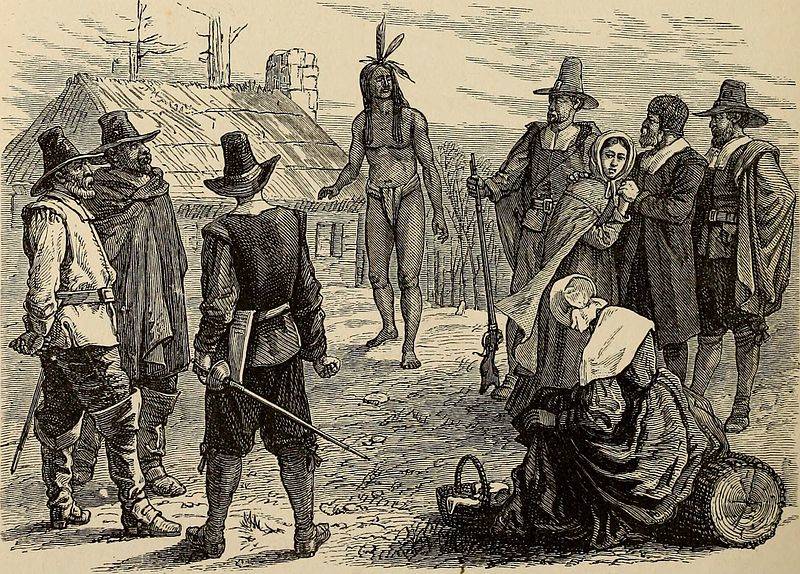
Wikimedia CommonsThe Pilgrims were astounded when Samoset approached them and addressed them in English.
If the Pilgrims had been surprised by Samoset’s command of English, they must have been shocked beyond belief by Squanto’s mastery of the language, which would prove to be useful for both parties.
With the assistance of Squanto as interpreter, the Wampanoag chief Massasoit negotiated an alliance with the Pilgrims, with a promise not to harm each other. They also promised that they would aid each other in the event of an attack from another tribe.
Bradford described Squanto as “a special instrument sent of God.”
The True Story Of Squanto And The First Thanksgiving
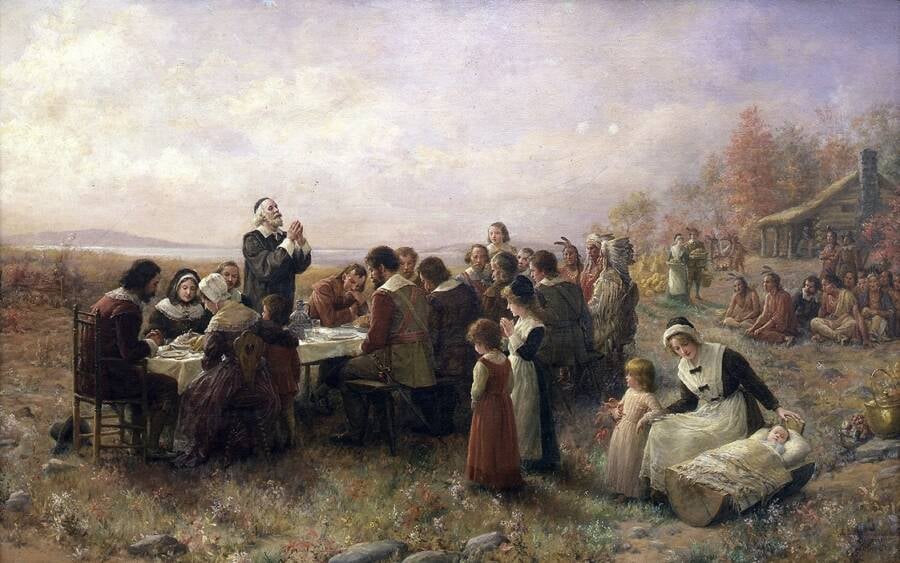
Wikimedia CommonsA 1914 rendering of the first Thanksgiving, an event that some say would never have come to pass without the help of Squanto.
Squanto worked hard to prove his value to the Pilgrims as not only a vital communicator but also an expert on resources.
So he taught them how to cultivate crops that would help them get through the next brutal winter. The Pilgrims were delighted to find that the corn and squash were easy to grow in the Massachusetts climate.
As an expression of their gratitude, the Pilgrims invited Squanto and around 90 Wampanoag to join them in a celebration of their first successful harvest in what they called the “New World.”
A three-day feast that took place sometime between September or November of 1621, the first Thanksgiving featured fowl and deer on the table — and plenty of entertainment around the table as well.
Though this occasion has been illustrated countless times in elementary school textbooks, the real-life Thanksgiving was not all fun and games. And the real-life Squanto certainly wasn’t either.
While the Pilgrims could not have survived without Squanto, his motives for assisting them may have had less to do with good-heartedness than seeking a sense of security — and gaining more power than he ever had before.
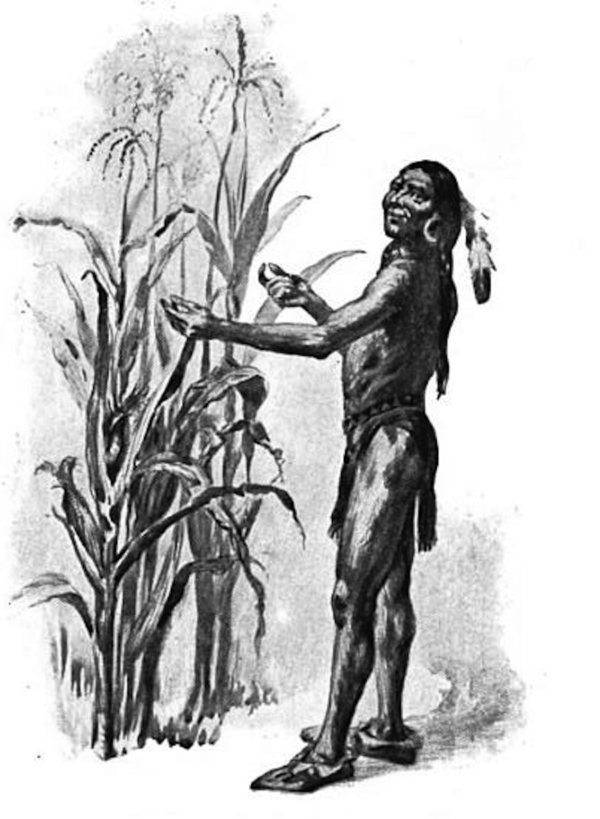
Wikimedia CommonsA depiction of Squanto demonstrating how to fertilize corn.
Inside Tisquantum’s Relationship With The Pilgrims
Squanto quickly developed a reputation for being manipulative and power-hungry. At one point, the Pilgrims actually appointed another Native American advisor named Hobbamock to keep Squanto in check.
After all, it’s easy to imagine that he may have secretly wanted to seek revenge on a group of people who had once enslaved him. On top of that, Squanto was aware of how valuable he’d become to the Wampanoag as the Pilgrims’ closest ally.
As Bradford put it, Squanto “sought his own ends and played his own game.”
In short, he exploited the power his fluency in English had given him by threatening people who displeased him and demanding favors in return for appeasing the Pilgrims.
By 1622, according to Pilgrim Edward Winslow, Squanto had begun to spread lies among both the Native Americans and the Pilgrims:
“His course was to persuade the Indians [that] he could lead us to peace or war at his pleasure, and would oft threaten the Indians, sending them word in a private manner we were intended shortly to kill them, that thereby he might get gifts for himself, to work their peace; so that whereas divers [people] were wont to rely on Massosoit for protection, and resort to his abode, now they began to leave him and seek after Tisquantum [Squanto.]”
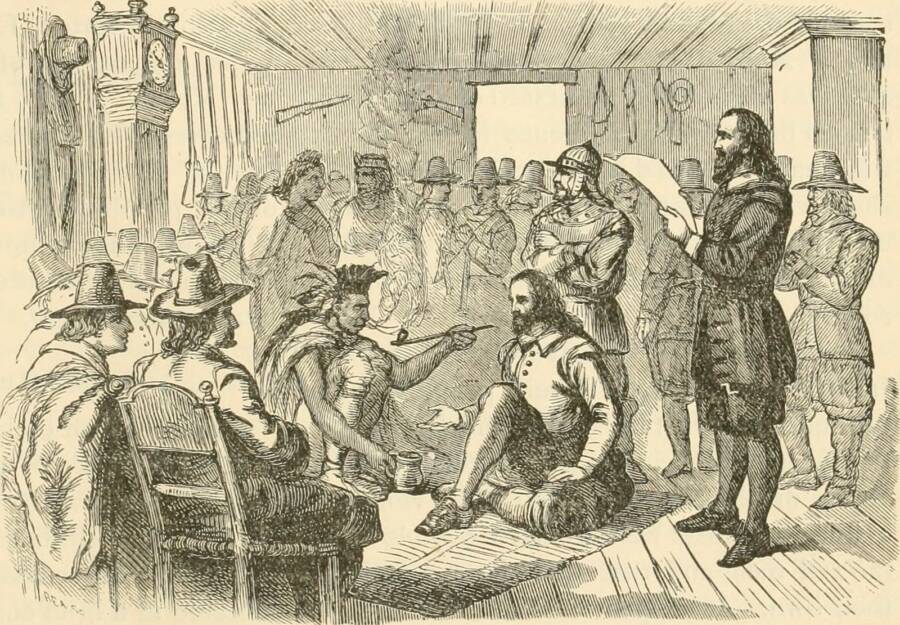
Internet ArchiveA rendering of Squanto, holding a pipe, and a number of Pilgrims.
Perhaps the best way to understand Squanto’s point of view is to take a closer look his name, Tisquantum, which was most likely not the name he was actually given at birth.
Per Smithsonian: “In that part of the Northeast, tisquantum referred to rage, especially the rage of manitou, the world-suffusing spiritual power at the heart of coastal Indians’ religious beliefs. When Tisquantum approached the Pilgrims and identified himself by that sobriquet, it was as if he had stuck out his hand and said, ‘Hello, I’m the Wrath of God.'”
What Happened To Squanto In The End?
Squanto’s wrath finally caused him to overstep his bounds when he falsely claimed that Chief Massosoit had been plotting with enemy tribes, a lie that was quickly exposed. The Wampanoag people were enraged.
Squanto was then forced to take shelter with the Pilgrims who, although they had also become wary of him, refused to betray their ally by handing him over to certain death among the natives.
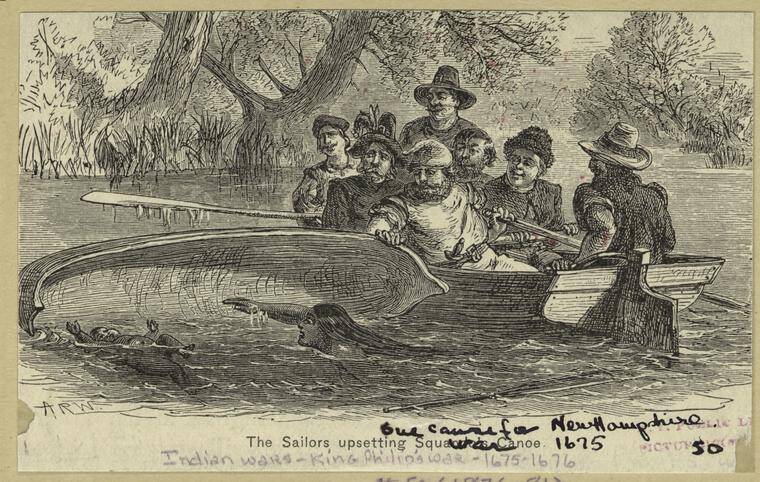
NYPLAn illustration of a Pilgrim canoe bumping into Squanto’s canoe.
It proved to not matter, since in November 1622, Squanto succumbed to a fatal disease while visiting a Native-American settlement called Monomoy, near what is now modern day Pleasant Bay.
As Bradford’s journal recalls:
“In this place Squanto fell sick of an Indian fever, bleeding much at the nose (which the Indians take for a symptom of [impending] death) and within a few days died there; desiring the Governor [Bradford] to pray for him, that he might go to the Englishmens God in heaven, and bequeathed sundry of his things to the sundry of his English friends, as remembrance if his love, of whom they had a great loss.”
Squanto was later buried in an unmarked grave. To this day, no one knows exactly where his body rests.
After learning about Squanto, read about the horrific crimes of the Native American genocide and its legacy of oppression today. Then, learn about Ishi, the “last” Native American to emerge from the wilderness in the early 1900s.





